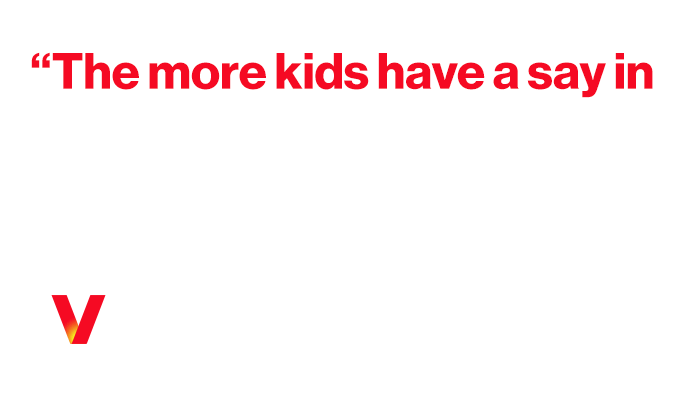- Press ToolsNews ReleasesMedia ContactsB-roll and imagesVerizon Fact SheetRSS FeedsEmergency ResourcesCable Facts
How to talk with kids about inappropriate content they see online
Open conversations can help kids think critically about what they see online. The goal: Help them make their own decisions about what feels safe and what’s not acceptable.

Like many parents, I used to think that bringing up sensitive topics like inappropriate content found online had to be done at just the right time and in just the right way. However, I’ve learned over the years that it’s far better for our children, and much easier on parents, to start these important conversations early.
Why? Our kids might be exposed to inappropriate content earlier than we expect. Studies show that it can happen to children as young as 7. However, parents can help their children prepare for these encounters by discussing early what your family considers inappropriate—and knowing how to handle the situation if (or when) your child does see something inappropriate online. As a parent of five boys and the founder of Parents Aware—an organization that assists parents in initiating these conversations—I’ve helped many families engage in these important discussions.

Building up to these discussions using correct language and terminology can show our kids that we are prepared to talk, that our home is a safe place to ask questions, and that nothing is too awkward or embarrassing to discuss. That said, sometimes circumstances force our hands, and we need to have the conversations sooner than we want to.
With that in mind, we’ve created this guide to help with the conversation, starting with what to do if your child is exposed to inappropriate content online—because that situation can be so urgent. We’ll also share an age-by-age guide to how to have meaningful conversations on this difficult topic.
Screenshot this for later

See an Objectionable Content Alert in Verizon Family?
- Don't assume the worst. Research suggests that children’s online searches are often driven by curiosity rather than intentional misbehavior.
- Use notifications as opportunities for open dialogue. Talk with your child about what makes certain content inappropriate.
- Pause and reflect before reacting. Take a deep breath and ask your teen what questions they have or if they need additional support from you.
- Listen with care and empathy.
verizon.com/parenting
Age-by-age guidance to prepare for content conversations
Ages 3–5: In most cases, children this age should not be left alone with any device that’s connected to the internet or has a camera—even when it’s something as simple as watching drawing videos or cartoons. Parents can also check the built-in parental controls on their devices as a safeguard against questionable content.
Ages 6–8: In my own research and experience with families, children this age can be exposed to inappropriate content online. This is when kids start to spend more time away from home with friends, at school or on playdates. It can be intimidating to bring up the topic of media safety with other parents. But I have found that families often share similar concerns. This makes having these conversations easier.
Some kids have food allergies. Some kids have nightmares when they watch scary movies. And some parents talk with other parents before a playdate or sleepover to make sure those needs are communicated. The media safety conversation can happen in that same space.
Try this question: “We have a family rule that kids at this age are only allowed to be on the internet when an adult is present. Is that a policy at your house?”
Ages 9–12: Many kids get their first phone around this age. Each new device that comes into the house is an opportunity to review your family’s media plan. I always encourage parents to get their kids involved in that plan.
It can start with a few self-reflective questions: “How can my media use align with my hopes, dreams and values? Does what I am doing today align with where I want to go?” Using the red, yellow and green light as a metaphor to stop, pause or go, consider the following:
Green light: Doing homework, talking with Grandma, or looking up videos about making something. Anything that reinforces those stated goals fall into this category.
Yellow light: Does the time you spend on a certain activity online take up most of the day? For example, when friends come over, can you put it down and spend time with them? Do you have trouble turning off the tech when asked?
Red light: Anything that doesn’t align with those hopes, dreams and values, and your families’ tech boundaries. Shut it down right away. Tell a trusted adult for added safety.
Age 13–18: At this age, kids are becoming more autonomous online. If they want to find something—even if it’s inappropriate content—they’ll find it. So they need to know there’s a safe place at home where they can ask important questions. Often, kids are afraid that if they do, they’ll get in trouble and lose their tech. Their fear of losing access to the phone can override their desire to talk about what’s going on.
I know stories about young women who have confided in friends, but not a parent, when they felt pressured to text intimate photos to someone at school.
That’s why we need to put these difficult conversations on the table. Kids are faced with difficult scenarios. It’s not fair to have them navigate these things on their own—to solve big adult problems without having someone they can talk to.

To make space for these conversations, consider the following:
Make ongoing connection a priority. Once a week or once a month, let them choose an activity, or a place to eat for lunch, or spend time talking together about something that interests them. The idea is to build a space for ongoing connection so it’s easier to talk about the tougher things.
Consider alternatives to taking the phone away as punishment. When boundaries get crossed, ask your teen to help you come up with some consequences instead of simply taking the phone away. Their solutions might surprise you. Another approach is to ask, “Would it be helpful to you if we set stronger tech boundaries together?”
Take the pressure off. If you’re just starting out, shoulder-to-shoulder conversations are best. Teenagers tend to open up more when the conversation feels more casual. So think of natural ways to avoid eye contact. Whether you’re riding in a car or making the family dinner together, these are ideal times to bring up challenging topics.
How to manage your child’s access to inappropriate content
The goal of these conversations is to raise critical consumers of technology. When the focus remains on blocking content, kids simply are not learning how to make decisions on their own. Family safety meetings can become a regular part of your tech routine—and another low-pressure way to talk about online safety together.
How to report inappropriate content online
If you or your child discovers inappropriate content of any kind on a social media platform or other space where it is prohibited, report it. The mechanics of reporting inappropriate content vary, but virtually all major platforms encourage users to report material that violates the platform’s guidelines.
However, never forward any sexual content that involves minors, even in an attempt to report it. Doing so is against federal law and it perpetuates the abuse of victims. For a detailed explanation and instructions on how to report child sexual abuse material (CSAM), read this article from Thorn.
You can do this
Sometimes I hear people say, “Kids don’t want their parents to talk to them about sensitive topics.” That’s simply not true. That sentiment implies we don’t know how to approach these conversations with our children. But we can work on that.
Looking back, if I could be a new parent again, afforded a do-over, I would place a greater priority on talking to my children about inappropriate content earlier. Of course, it is never too late. My children are older, and frankly, because I now have the courage to be open and honest with them, our conversations are much better. We laugh more, and the trust between us has grown. These conversations have the potential to strengthen parent-child relationships and can bring you and your child closer together.
The right tools can help you know when to step in and talk. Try Verizon Family.
Marilyn Evans is a writer and speaker. She founded Parents Aware to help parents have open honest conversations with their kids about pornography, sex and relationships. Evans also hosts the Media Savvy Moms podcast.
The author has been compensated by Verizon for this article.
